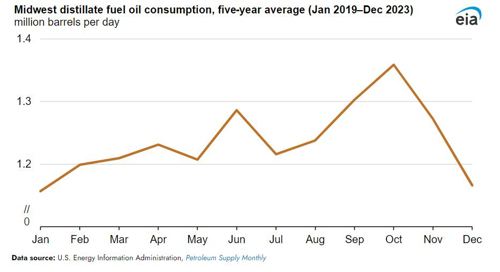U.S. distillate fuel oil demand will increase in the fall due to agricultural harvest
The U.S. Energy Information Administration (EIA) expects distillate fuel oil consumption to increase in the fall as diesel-powered agricultural equipment is used to harvest and transport crops.

The harvest tends to peak in mid-October and continue through November, when the start of the winter home heating season also supports distillate fuel oil demand. With early indications that the 2024 harvest will likely be on schedule or slightly ahead of schedule, the EIA expects distillate demand to generally follow the five-year average in 2024.
What factors affect distillate fuel oil demand? Most distillate fuel oil in the U.S. is consumed in the on-road transportation sector, which includes medium- and heavy-duty trucking. Large volumes of distillate fuel oil are also consumed in the commercial, industrial, and rail sectors. As a result, U.S. distillate fuel oil demand is strongly tied to economic conditions.
However, seasonal factors can also affect U.S. distillate fuel oil demand. Because diesel fuel powers most farm equipment in the U.S. and is used to transport harvested crops, distillate fuel oil consumption changes seasonally with agricultural schedules. Although diesel is used for routine planting, crop tilling, weed control, and other farming operations all year round, demand for diesel increases during the fall harvest season.
The growth of conservation tillage and no-till farming, which reduce the need for diesel-powered equipment in the spring, further emphasizes stronger demand in the fall. Other seasonal factors that can affect distillate fuel oil demand are the winter home heating season and the transportation of goods ahead of the holiday season.
How do seasonal factors affect distillate fuel oil demand? In the last five years (2019–2023), U.S. consumption of distillate fuel oil has increased by an average of 4% between September and October, primarily because of agricultural harvest trends.
Although planting and harvest seasons differ by crop, most of the agricultural harvest takes place between September and November, with October being the peak month. Most harvesting takes place during these months because this period is primarily when corn and soybeans are harvested. In 2024, among the principal crops included in the U.S. Department of Agriculture’s (USDA) “Acreage” report, corn comprised nearly 30% of the U.S.’ planted acreage, and soybeans comprised more than 25%. Many other crops are also harvested in the fall.

U.S. consumption of distillate fuel oil typically decreases slightly in November as the agricultural harvest slows down. However, the start of winter heating demand partially offsets this effect and is one reason more distillate fuel oil is consumed in the U.S. in November than in September, despite similar harvest acreage in the two months.
This November, the EIA expects less-than-average U.S. consumption of distillate fuel oil in part because of expectations of a relatively warm November. Winter heating demand in the Northeast, a region that relies on heating oil to heat almost 20% of its homes, tends to remain strong through March and contributes to high distillate fuel oil demand in many of the winter months.

Where are the effects of harvest-related distillate demand most relevant? Because corn and soybean crops are mostly planted in the Midwest, the seasonal effects of agriculture on distillate demand are primarily concentrated in the Midwest. These effects are also easier to isolate in the Midwest because distillate fuel oil is not commonly used for home heating in the region.
With minimal demand for distillate as a heating fuel, Midwest distillate demand generally follows the harvest schedule. Midwest distillate fuel oil consumption regularly peaks in October, with September and November being the next top months.

In anticipation of harvest season, Midwest distillate fuel oil inventories typically increase in the summer, peaking in mid-September before sharply falling until late-November, when the harvest is complete. Midwest distillate fuel oil inventories typically decrease about 25% during the fall harvest season.

In 2024, Midwest distillate fuel oil inventories entered the fall harvest season slightly below average. A series of refinery outages in Chicago and Ohio reduced refinery utilization in July and August, limiting distillate fuel oil production in the Midwest. Those refineries resumed normal operations in mid-August, however, and Midwest distillate fuel oil inventories have risen close to average levels.
How is the 2024 harvest season progressing? This year, a couple of early markers indicate that peak harvest could be slightly earlier than average in the U.S. The corn and soybean crops are progressing slightly ahead of schedule, according to the USDA’s “Crop Progress” report. In addition, the ratio of soybean acreage to corn acreage is higher than in previous years, and soybeans have a slightly earlier harvest season than corn. An earlier harvest season could increase distillate fuel oil consumption in September and October and decrease it in November.
However, annual variations in harvest size and timing are typically not large enough to significantly disrupt the seasonal consumption trend. Initial data suggests the harvest will likely only occur slightly ahead of schedule, so the EIA expects 2024 distillate fuel oil consumption to generally follow the pattern of previous years.






Comments